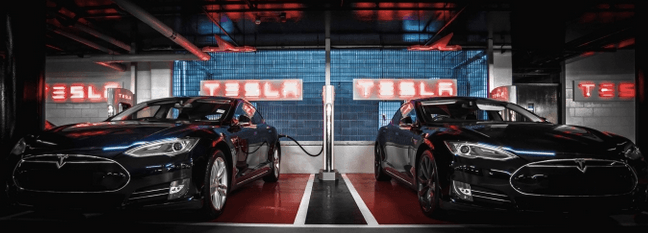
In a nifty turn of reverse marketing, luxury electric vehicle maker Tesla Motors aims to make its cutting-edge mobile battery technology a workhorse for the stationary energy storage sector. Bloomberg News reported that Tesla will introduce batteries for commercial and residential use this week, following through on a promise company CEO Elon Musk made earlier this year.
For those of you familiar with Mr. Musk, the move is no big shocker. Musk is also chairman of the leading U.S. residential solar installer SolarCity, which is already offering Tesla-branded batteries to its rooftop solar customers. The new announcement could break the energy storage market wide open into non-solar customers as well.
Why invest in energy storage without solar energy?
The question for business is: Why would you invest in on-site energy storage if you don't have an on-site solar array?
After all, the main reason to pair a battery with solar panels is to store energy when the sun is shining, so you can still get zero-emission electricity at night or during inclement weather. And to be clear, the new Tesla venture seems aimed primarily at storing solar energy.
However, additional benefits of energy storage are emerging that apply across all properties, with or without on-site solar (or, for that matter, on-site wind turbines).
Foremost is the rise of the demand-response model for grid electricity rates. Utilities have been adopting more pathways to help customers ease off their electricity use during peak hours, and energy storage plays a pivotal role in this trend.
The attraction for business is that you can shave down your electricity costs by charging up your battery and storing energy during scheduled off-peak hours, when rates are lower. To avoid brownouts and other disruptions, utilities are also beginning to use smart grid technology to request demand cutbacks on the fly, so businesses with energy storage will be able to take advantage of those incentives as well. Reducing the need to build expensive new "peaking" plants is another plus for utilities.
Another strong benefit is the ability to rely on a quiet, zero-emission source of electricity in case of power outages, rather than having to rely on a noisy diesel backup generator.
The backup benefit is becoming more urgent, as a warming global climate has contributed to an increase in the risk of grid outages from damaging storms.
It's also worth noting that in the health care sector, the trend toward in-home and clinic-based care will bring about an increase in the need for small-scale backup power systems to keep medically necessary equipment running, in addition to simply keeping the lights on.
Domesticating the Tesla electric vehicle battery
Despite its relatively short history in the automotive field, Tesla has already become known for its high-end, high-tech, high-performance engineering.
That reputation applies especially to the company's long-range, lithium-ion electric vehicle battery and its growing network of super-fast charging stations.
All that cutting-edge technology comes at a cost, of course. While Tesla has been trying to broaden its customer base with more attractive financing and the introduction of more affordable vehicles, the company's signature Model S is too pricey for most car buyers.
You might assume that a similar obstacle would apply to Tesla's new stationary battery, but you might be wrong about that.
As reported by Dana Hull of Bloomberg News last week, Tesla has been quietly working with California's SGIP, the Self Generation Incentive Program, to procure rebates for its stationary batteries at scores of sites throughout the state.
Hull puts the figure at more than 100 projects for Tesla, which is pretty impressive when you take a look at SGIP's overall record.
SGIP launched in 2001 as a means of smoothing out spikes in energy demand across the California grid, and it recently reported that to date it has 544 projects under its belt.
When the program started it had an integrated solar component, but in 2006 the solar aspect was farmed out to the California Solar Initiative. That's partly why we're guessing that Tesla's close relationship with SGIP could help propel the market for on site energy storage, with or without on site solar.
Energy storage market is mushrooming
Building on its recent work with SGIP, Tesla has also been taking steps to position itself for new growth in the California energy storage market, as indicated by a December 2014 workshop in which the company proposed a low-cost alternative for interconnection in PG&E territory.
Last week, Bloomberg's Dana Hull reported that utility-scale energy storage is also in the works for Tesla.
The company already has Wal-Mart and Cargill in its stable. Schools, factories, and wineries in California are also likely targets for large-scale batteries.
Helping things along, according to Hull, is a potential pile of $65 million in SGIP rebates for Tesla projects.
Tesla is expected to make a public announcement about its stationary battery sales program on April 30, so stay tuned for more details.
Meanwhile, Hull reports that energy storage investment in the U.S. is expected to surge more than 10 times over the current rate by 2019, adding up to $1.5 billion.
The takeaway: Businesses that invest in energy storage will have a leg up on the competition when it comes to bottom line electricity costs as well as energy security, especially when paired with on-site solar or wind power.
Image credit (screenshot): Courtesy of Tesla Motors.

Tina writes frequently for TriplePundit and other websites, with a focus on military, government and corporate sustainability, clean tech research and emerging energy technologies. She is a former Deputy Director of Public Affairs of the New York City Department of Environmental Protection, and author of books and articles on recycling and other conservation themes.














